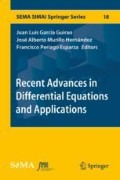Abstract
We consider dynamical systems arising in biochemistry and systems biology that model the evolution of the concentrations of biochemical species described by chemical reactions. These systems are typically confined to an invariant linear subspace of \({\mathbb R}^n\). The steady states of the system are solutions to a system of polynomial equations for which only non-negative solutions are of interest. Here we study the set of non-negative solutions and provide a method for simplification of this polynomial system by means of linear elimination of variables. We take a graphical approach. The interactions among the species are represented by an edge labelled graph. Subgraphs with only certain labels correspond to sets of species concentrations that can be eliminated from the steady state equations using linear algebra. To assess positivity of the eliminated variables in terms of the non-eliminated variables, a multigraph is introduced that encodes the connections between the eliminated species in the reactions. We give graphical conditions on the multigraph that ensure the eliminated variables are expressed as positive functions of the non-eliminated variables. We interpret these conditions in terms of the reaction network. The results are illustrated by examples.
Access this chapter
Tax calculation will be finalised at checkout
Purchases are for personal use only
References
Conradi, C., Feliu, E., Mincheva, M., Wiuf, C.: Identifying parameter regions for multistationarity. PLoS Comput. Biol. 13 (2017). Available at arXiv:1608.03993
Farina, L., Rinaldi, S.: Positive Linear Systems: Theory and Applications. Series on Pure and Applied Mathematics. Wiley-Interscience, New York (2000)
Feliu, E., Wiuf, C.: Variable elimination in chemical reaction networks with mass-action kinetics. SIAM J. Appl. Math. 72, 959–981 (2012)
Feliu, E., Wiuf, C.: Variable elimination in post-translational modification reaction networks with mass-action kinetics. J. Math. Biol. 66, 281–310 (2013)
Feliu, E., Wiuf, C.: Simplifying biochemical models with intermediate species. J. R. Soc. Interface 10 (2013). https://doi.org/10.1098/rsif.2013.0484
Feng, S., Sáez, M., Wiuf, C., Feliu, E., Soyer, O.S.: Core signalling motif displaying multistability through multi-state enzymes. J. R. Soc. Interface 13 (2013). https://doi.org/10.1098/rsif.2016.0524
Laurent, M., Kellershohn, N.: Multistability: a major means of differentiation and evolution in biological systems. Trends Biochem. Sci. 24, 418–422 (1999)
Millan, M.P., Dickenstein, A., Shiu, A., Conradi, C.: Chemical reaction systems with toric steady states. Bull. Math. Biol. 74, 1027–1065 (2012)
Monod, J., Wyman, J., Changeux, J.P.: On the nature of allosteric transitions: a plausible model. J. Mol. Biol. 12, 88–118 (1965)
Moon, J.: Some determinant expansions and the matrix-tree theorem. Discrete Math. 124, 163–171 (1994)
Ozbudak, E.M., Thattai, M., Lim, H.N, Shraiman, B.I., Van Oudenaarden, A.: Multistability in the lactose utilization network of Escherichia coli. Nature 427, 737–740 (2004)
Qian, H., Beard, D.A.: Metabolic futile cycles and their functions: a systems analysis of energy and control. IEEE Proc. Syst. Biol. 153, 192–200 (2006)
Roman, S.: Positive solutions to linear systems: convexity and separation. In: Advanced Linear Algebra. Graduate Texts in Mathematica, vol. 135. Springer, New York (2005)
Sáez, M., Feliu, E., Wiuf, C.: Graphical criteria for positive solutions to linear systems. Linear Algebra Appl. 552, 166–193 (2018). Available at arXiv:1709.01700
Thomson, M., Gunawardena, J.: The rational parameterization theorem for multisite post-translational modification systems. J. Theor. Biol. 261, 626–636 (2009)
Xiong, W., Ferrell Jr, J.E.: A positive-feedback-based bistable ‘memory module’ that governs a cell fate decision. Nature 426, 460–465 (2003)
Acknowledgements
This research was supported by the Lundbeck Foundation (Denmark) and the Danish Research Council.
Author information
Authors and Affiliations
Corresponding author
Editor information
Editors and Affiliations
Rights and permissions
Copyright information
© 2019 Springer Nature Switzerland AG
About this chapter
Cite this chapter
Sáez, M., Feliu, E., Wiuf, C. (2019). Linear Elimination in Chemical Reaction Networks. In: García Guirao, J., Murillo Hernández, J., Periago Esparza, F. (eds) Recent Advances in Differential Equations and Applications. SEMA SIMAI Springer Series, vol 18. Springer, Cham. https://doi.org/10.1007/978-3-030-00341-8_11
Download citation
DOI: https://doi.org/10.1007/978-3-030-00341-8_11
Published:
Publisher Name: Springer, Cham
Print ISBN: 978-3-030-00340-1
Online ISBN: 978-3-030-00341-8
eBook Packages: Mathematics and StatisticsMathematics and Statistics (R0)

